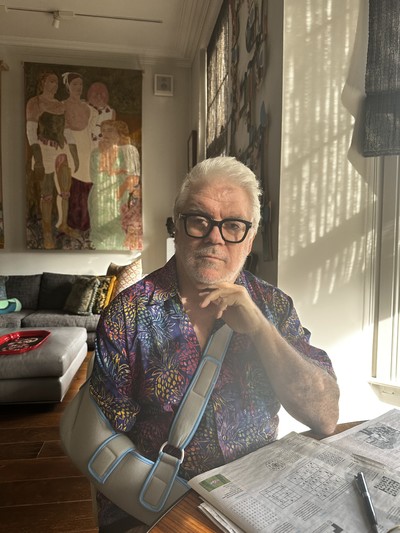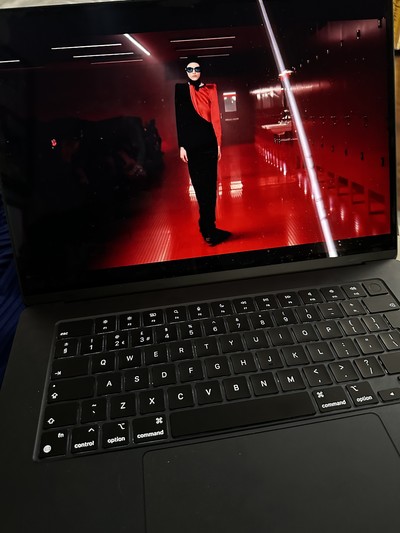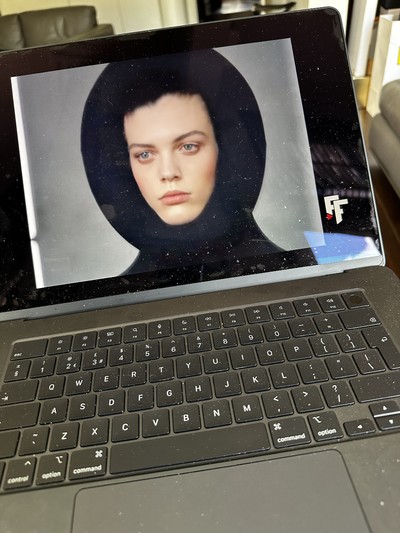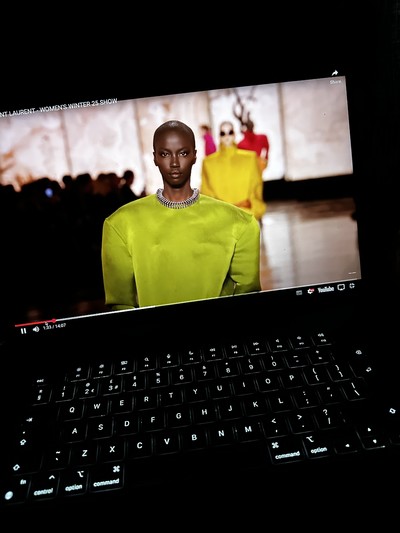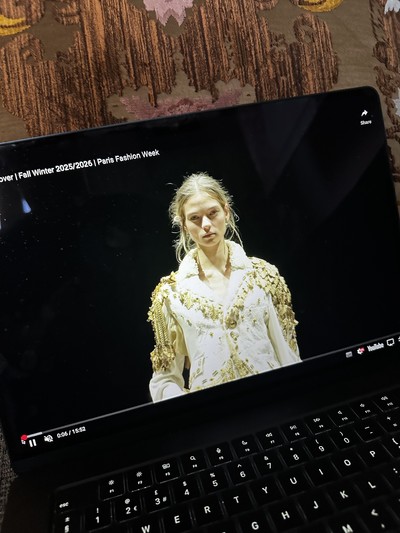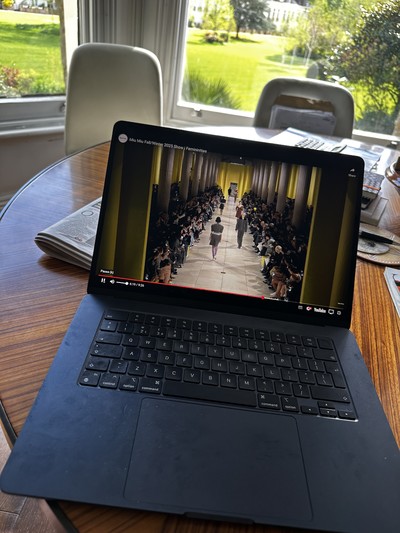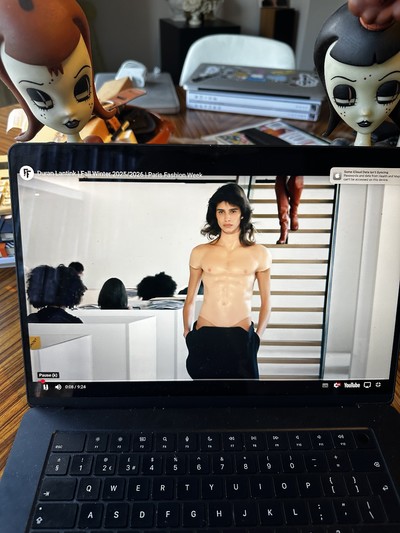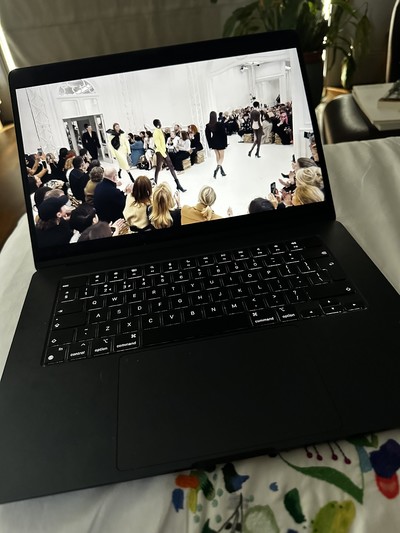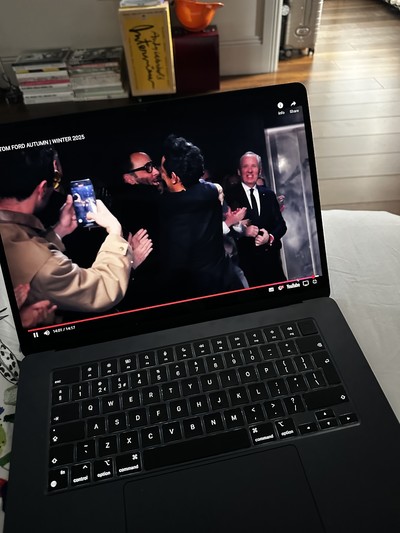Interview by Jonathan Wingfield
‘The world right now seems to be specializing in unprecedented events – between genocide and tariffs and absolutely monstrous upendings of humanity and everything that we hold dear. And then fashion’s contribution is going to be this enormous change within all these different
houses. It’s everything we’ve ever wanted, in a way. September is going to be so incredible, I’d be a fool not to return.’
In early January, while strolling along London’s Bond Street, Tim Blanks gazed upwards at Cartier’s beguiling Christmas decorations causing him to trip on the curb and take an abrupt tumble. This momentary ‘fatal distraction’, as he now calls it, resulted in an arm broken in three places, five heavily cracked ribs, and fashion’s beloved writer (and reluctant critic) forced to sit out the entirety of the Autumn/Winter 2025 season fashion shows. It was the first time in almost 40 years – give or take a Covid season or two – that the ever-jovial New Zealander wasn’t casting his wildly descriptive eye over catwalk proceedings; instead, forced to watch the shows via livestreams as he licked his wounds at home in the English capital. During those four decades, he’s edited magazines in Toronto, hosted the much-loved Canadian TV show Fashion File, written wonderfully evocative show reviews during style.com’s heyday, and, since 2016, taken on the role of Editor-at-Large at The Business of Fashion. Beyond anything on his CV though, Tim Blanks’ longstanding contribution to fashion is his enthusiasm and unrivalled skill for expressing the thoughts and intentions of countless designers – in doing so, adding layers of cultural resonance, meaning and sheer emotion to what’s sent down the catwalk each season. Suffice to say his absence was felt between mid-February and mid-March.
Twelve weeks to the day since his fateful accident, Blanks graciously agreed to, well, remain sitting down for a chat with System about this most anomalous of fashion seasons for him, and indeed for the industry at large, as it navigated a combination of socio-political upheaval, economic uncertainty and an unprecedented number of luxury fashion houses on the cusp of a creative reboot. Furthermore, President Trump’s so-called ‘Liberation Day’ announcement sent further shockwaves on the very eve of our conversation, and so with tariffs firmly on his mind, and the equal discomfort of a be-slinged arm, Tim Blanks was ready to ‘get into it’.
Jonathan Wingfield: Given that you didn’t attend the shows this season, I’m curious to know if what’s on your mind is wildly leftfield of those that did, or exactly the same?
Tim Blanks: I guess I’m thinking about tariffs and Duran Lantink. I’ve just been a judge this week for the Woolmark Prize. And Duran won. I’ve been a judge pretty much every year since the prize was relaunched in 2012, and there’s never been such unanimity. Lately, they’ve been adding more designers to the jury, but before it was mainly judges from retail or editorial – buyers and editors. Whenever there seemed to be a clear winner, that designer would have already won every other prize under the sun, and so the debate, at least from the perspective of the creative or editorial jury members, would be, ‘Let’s give it to somebody whose life it will change,’ because it’s quite a good prize. I remember the year that Rahul Mishra won [2014], the commercial side of the jury was fighting for Joseph Altuzarra, who had just got backing from Kering, while the creative side was fighting for Rahul. It was ‘little David’ versus Kering-backed Goliath. We 12 Angry Men-ed it out for quite a while, and Rahul ultimately won. This year, you could say that Duran has won practically everything going, but it was just so inescapable. One of the criteria for the Woolmark is that the winner should be a good ambassador for wool fibre, and with Duran you have those extraordinary shapes that were hand knitted by 15 women in Amsterdam, and then there’s the science aspect of what he does in construction. That convergence neatly represents the future of wool.
Do you think Duran is deserving of the huge sways of interest and accolades that have been showered upon him this season?
Above and beyond his talent and his ingenuity, you can see people are feeling excited and looking forward to what he does, and that’s what fashion has been missing for so long. All the talk about him becoming the designer for Gaultier is interesting, because when you think about what a Gaultier show or collection meant it really was defined by that sense of excitement. I often ask myself, where is that today? And then Duran comes along with something completely leftfield, yet it isn’t gratuitously abstract. There’s a real logic to it. And there’s incredible technique coupled with strange sensuality, humour, a fabulous sense of anarchy, and social commentary as well – all the things that Gaultier bowled me over with when I began going to his shows in the 1980s.
Actually, what was the first catwalk show you ever attended in Paris?
When I became the editor of Toronto Life Fashion magazine in Canada, I thought it was very important to have a presence in Europe – utterly self-serving, of course – and so my first season in Paris was Spring/Summer 1988 couture. In fact, my very first show that season was Saint Laurent, the couture collection with the Braque doves and the Picasso guitar. It was just beyond. I remember walking along the corridors of the Intercontinental Hotel [Saint Laurent couture show venue] with Krystyne Griffin, the formidable fashion maven who ran Yves Saint Laurent Canada. Walking just in front of us was a woman whose ankles were so skinny they looked like they were glass and would shatter if she put her foot down too hard. When she turned around, it was Nan Kempner. Krystyne introduced me to her. I knew exactly who she was because I was an avid reader of W magazine which covered all the society ladies. Let’s just say, it was a moment.
‘I was this blimp from Toronto with a black tooth. Initially the whole Canada thing was crippling. Karl Lagerfeld just called me ‘Canada’ for years.’
After almost 40 years of attending fashion shows – give or take a Covid season or two – this was your first season absent from Paris. How did it feel to not be there in person?
During the pandemic, everybody was in a position of compromise, and so if I was watching a livestream of a show, everybody else was doing that. Whereas this season I was watching a livestream of something actually happening, with an audience – and possibly a seat in there somewhere with my name on it. But I think livestreaming got a glow-up since the pandemic. Some of the shows I was watching felt like they were being staged for the livestream. With Balenciaga, for example, I realized that if you were in the audience, you wouldn’t actually have noticed any of the wider context that you saw on the livestream; you wouldn’t have realized that you’re sat in a small and walled section of a much larger labyrinth. But with a drone relentlessly covering every square inch of the venue, you see it all on screen, plus you see close-ups. The cliché is that it’s the difference between the movies and the theatre, and while you may not be seeing the smallest drop of sweat on the model’s brow, you’re definitely seeing the shimmer of her sequinned dress up close. You’re appreciating the masterful work of the hair and make-up team, too, more than when you’re in the room. I was actually wondering if the livestream is now a principal consideration for make-up artists when they’re working on shows.
So you’re now a livestream evangelist.
Well, the other thing it captures is those step-and-repeats, where you see people wearing the brand’s clothes before the show starts. I got completely mesmerized by that constant arrival of people, some of whom you recognize, and others you don’t. There’s a celebrity angle, like at Miu Miu, with all the starlets wearing them, but then at Off-White, it felt more like it was Ib [Kamara]’s friends. I found it so revelatory to see the clothes being worn on real people, not just on models in a fashion show. It really seduced me to watch and enjoy that collection.
This season aside, what’s your rapport with attending shows these days? Does it remain the backbone of your professional activity?
For sure. I still think fashion is a physical thing, and it is important to be in the venue for the show. I talked to Haider Ackermann [remotely] before his Tom Ford show, for a preview piece I was writing for BoF, and he was telling me about the set that Niklas Bildstein Zaar designed for him – it was so good. And then I’m watching the livestream of the show, and I’m thinking, you can’t really see it! I texted people who were attending if they could see what the backdrop was… It was quite subtle as it was dark in that room.
What was the concept of the set?
Haider used to work in a club in Antwerp’s red-light district. All the hookers would come in at the end of the night and he’d have a drink with them. He knew the rooms that they worked in, where there’d be mirrors that people would write things on – obscene messages, doodles, phone numbers. And he said that the walls of the show set were supposed to duplicate those mirrors, with messages and scribbles and phone numbers on them. When Niklas showed me the set without anybody in it, and with no lights on, it did kind of look like what Haider had been describing. But when I asked Vikram [Alexei Kansara, editorial director at The Business of Fashion] to have a look on the day, he didn’t get a strong sense of that. So watching it on a livestream, the story felt strangely more amplified for me than if I’d actually been sitting there. Obviously, I did miss the wave of emotion at the end of the show; that’s the physicality and ambience of a fashion show… But for most people there, you’d have been hard-pressed to have actually seen that embrace. So there are all these little details that you miss if you’re in the venue.
Katie Grand said they were serving martinis at the show…
…which is a perfect Tom Fordian thing.
‘Alessandro was such a unique paradigm: pluck a complete unknown from obscurity, give him two weeks to do a collection, and he changes the world.’
Do you feel like you’ve missed a lot this season?
I think I’m past missing things. The world is in such a powerless state that regret is a really pointless indulgence. I enjoyed watching my livestreams, I didn’t miss the early starts, the Paris traffic, the waiting, the late nights, the writing and the deadlines… although I probably will again.
How do you feel about the prospect of returning next season? What with all the changes afoot…
September is going to be so incredible, I’d be a fool not to return. The world right now seems to be specializing in unprecedented events – between genocide and tariffs and absolutely monstrous upendings of humanity and everything that we hold dear. And then fashion’s contribution is going to be this enormous change within all these different houses. It’s everything we’ve ever wanted, in a way.
It reminds me of that exhibition at the Palais Galliera – 1997 Fashion Big Bang – about Marc Jacobs starting at Louis Vuitton, Nicolas Ghesquière starting at Balenciaga, Galliano at Dior, McQueen at Givenchy, Margiela at Hermès, the Colette store opening… With the beauty of hindsight, you see it as this reshuffling of fashion. And next season feels like it’s going to be a similar reshuffling.
One of the other Woolmark judges had made a list of all the changes coming up in September, and it was unbelievable.
Between all the imminent change in fashion and the turmoil in the wider world, did you sense that there was much direct response to global affairs on the runway this season?
I remember when Russia invaded Ukraine, you had a designer like Rei Kawakubo acknowledging ‘the lie of war’ in her collections. It felt to me like fashion decided to be the mirror. I’ve said this a million times before: fashion reflects and fashion projects. So there have been moments in the past where the horror could be encapsulated in a way that you could say something about it in your collection. But I think the horror right now has become so cataclysmic and such an offense to humanity that you’re left thinking, ‘How do you respond to that when you’re… making a dress?’ That said, many of the designers at the Woolmark Prize talked about the community that they work with, and that they serve. For someone like Raul [Lopez] at Luar, the threat to trans rights is obviously huge. So he will inject that element into his work, he will celebrate it, and that will be his way of confronting the monstrous things that are happening. Of course, there are other media – art, film, theatre, literature – where you can absolutely bare your soul, and fashion has been that at times. McQueen certainly was, but it’s been a while since I’ve really felt like fashion’s been torn from today’s headlines.
Do you think that’s because the role of the fashion designer is teetering more towards the commerce and less towards the art?
The system has been shaped so that we are all pawns in somebody else’s game. All those designers are as well.
‘Is Demna going to do something else equally strong for Gucci, and reveal another facet of his personality that we’ve yet to see? It’s so intriguing.’
The other people we’ve been talking to for these interviews have mentioned that young designers seem to want to do things more at their own pace, at their own scale, and that the use of hand skills is returning to the fore.
Well, it’s E.F. Schumacher’s Small is Beautiful battle cry. That has a moment with each generation. What struck me with all these young Woolmark designers is their take on sustainability. Of course, sustainability is such a weird chimera, because the fashion industry is built on consumption, and consumption produces waste and so on. But these designers are now talking about after-sale care. So when you get tired of a Duran outfit you can take it back to him, and he will remodel it for you. Many of them are offering this repairing or remodelling or reimagining service, and that felt to me like a rebuttal. Everybody talks about Shein or Primark as the primary sinners in this buy-something-for-five-pounds-wear-it-once syndrome, but isn’t the enormous product churn of the big luxury houses the same type of over-consumption – just at the other end of the spectrum? It makes you think, what would fashion be like in a post-apocalyptic world? It would be dressmakers, it would be tailors, it would be cobblers…
It would be less moodboards.
[Laughs] Yes! I mean, men used to have suits made for them as a matter of course, not because they wore fancy pants. And so it seems to me that this sort of humanism is a response to the world, and that they’re really trying to emphasize the humanity in what they do.
Is there a very real possibility that future generations of young consumers might feel less aligned with the values of the big luxury brands?
It’s happening right now, and all those merchandisers are reeling about the fact that their bags aren’t selling. The merry-go-round spun for a long, long while, but it got so fast that entropy set in. And after entropy, there is this complete and utter stasis, and that’s where we are.
Luxury fatigue?
I’d be more inclined to call it ‘sticker shock’. Just astronomical pricing! Something that was £300 pounds is now £1,300. And yet – once again at the Woolmark Prize – when you look at the line sheets of these younger designers, they’re all so price conscious, it’s quite incredible. I asked one of them, ‘Is this the wholesale price?’ and they said, ‘No, that’s the retail price.’ They’re very, very reasonable, and they’re very aware of the nonsensical pricing of many established houses. In any case, if you’re a young designer setting out your stall today, there’s little point in trying to sell a blouse for £20,000.
Is now the time to mention tariffs?
It’s astonishing to read that tariffs are going to increase prices even more because companies aren’t going to take a bite from their bottom line; they’re going to just pass it on to the consumer by upping the price of the handbag even more.
That’s a sobering thought. Let’s turn our attention to the shows themselves. Starting with New York, and Veronica Leoni’s debut collection for Calvin Klein. It made me think, ‘What role should Calvin Klein be playing today in American fashion?’ And ultimately the broader and more complex question: What do you think New York can be today as a fashion capital?
I think people wanted and really needed that show to be good. Although I guess the response suggests that it wasn’t. New York is a bit like London, in that it has its incredible moments and then it goes into a fallow period. But I guess all the young designers who are working away there would understandably feel insulted to hear me suggest it’s in a fallow period.
The Row have been in Paris for a while; Vaquera have gone there too. Proenza Schouler are deserting their own New York label for Loewe… New York is struggling to hold onto its own.
I think American fashion has been a victim of Darwinism in the same way the movie industry has. It just feels like it’s much harder to be a young, independent person operating in America. Maybe it always was, but it feels a lot more Darwinian there than it does elsewhere. Although I look at Luar, and Raul’s passion and his commitment, and the fact that he’s so articulate makes me think what a fabulous spokesperson he is for a fashion generation.
As you’d mentioned before, he’s particularly emblematic of a designer who’s designing for his community.
London is the same thing, it’s always about community, but it’s having a very hard time as well. And yet I look at someone like Jawara Alleyne, whose collection I loved, and wonderful people like Supriya Lele. You can see in an ideal world what those people would be… but we’re not in an ideal world.
‘When I got my CFDA award they asked me who I’d like to give me the award. And I said Trent Reznor. And they replied, ‘Errr… anyone else?’’
When you think about Paris from an industry perspective, LVMH has become the defining ‘brand’. It’s come to represent what fashion means in the city. And by the same rationale, you could argue that the most enduring and defining London ‘brand’ is actually Central Saint Martins.
What a fabulous thought. It absolutely defines London. That gives London its own niche. The problem is Brexit has fucked that up. I mentor 75 students in the fourth year at Polimoda, and I don’t know how many of them would have gone to Saint Martins if they could have, but it’s just so hard to get in, and so expensive, so all the schools in Europe are getting this spillover business. But the idea that London’s most durable contribution to the tree of fashion would be Central Saint Martins – or perhaps the broader notion of fashion education – is wonderful.
Let’s talk about Milan. Did the news of Demna going to Gucci come as a surprise to you?
I felt it had been in the wind. I don’t know why, because it’s certainly a surprising idea. Maybe it was BoF where I read that Demna did an incredible presentation to get that [Gucci] job. I think he’s a really, really fantastic designer, and he clearly has a very strong personal signature. But is he going to do something else for Gucci that would be equally strong and maybe reveal another facet of his personality that we haven’t seen before? It’s intriguing. The challenge of what’s going to resuscitate people’s interest in Gucci is a pretty major one, and that kind of Alessandro Michele lightning doesn’t strike very often. It was such an interesting paradigm: you take a complete unknown, pluck him from obscurity, give him two weeks to do a collection, and he changes the world. It’s the ultimate fashion fairy tale.
Demna was 10 years at Balenciaga, Jonathan Anderson was 10 years at Loewe. That’s a particularly tough act to follow. They’re big shoes to fill.
In Loewe’s case, shoes so big they need two people to fill them.
Celine’s business at the point of Phoebe Philo’s departure was estimated to be about 500 million euros. Hedi Slimane came and effectively dismantled that brand and business – the existing customer went elsewhere – and LVMH then had to invest hundreds of millions, if not more, in order for it to reach today’s scale, which must be nearer two or three billion euros. Ultimately, the risk absolutely paid off. But when you think about the prospect of Jonathan Anderson’s quite radical creative direction dismantling an existing €10-billion business like Dior… that’s a monumental risk. I mean, what happens to all those Peter Marino-designed stores? Are they suddenly subject to a Jonathan Anderson makeover? There is risk and uncertainty built into all of these creative reboots, but the further up the scale the higher the stakes become.
Yes, you’re right. Is Jonathan Anderson going to sit down with Peter Marino and say, ‘Let’s redesign your all Dior shops’? Is Peter Marino going to say, ‘Don’t you touch my stores’? Can one single designer successfully do men’s and women’s and couture at Dior?
Is there enough in the Givenchy brand – beyond Audrey Hepburn and the Little Black Dress – for Sarah Burton to transform it into a dominant cultural force?
Givenchy was of a time, and it’s since been through how many designers… seven… eight? Julien Macdonald, Ozwald Boateng, McQueen, Galliano, Riccardo Tisci, Matthew Williams, Clare Waight Keller… to the point that whatever the original personality is, it’s literally Audrey Hepburn in Breakfast at Tiffany’s. You can’t get around that. Sarah acknowledged it by doing that little dancy thing which I thought was very smart. She basically said, ‘Audrey Hepburn is in the story, here she is in the first look, and now it’s gone.’ There’s no little black dress or anything. And I thought the collection was an audition for couture, because they’re going to revive couture under her. It was a strong, classic couture collection that people wear in the daytime. I liked what she did. I thought it was a good start, and I thought I could see how it will adapt to couture well.
‘Is Jonathan Anderson going to sit down with Peter Marino and say, ‘Let’s redesign all your Dior stores’? Will Peter Marino say, ‘Don’t you touch my stores’?’
Tell me about something you saw on the catwalk this season that felt genuinely new?
I’m just trying to run through Jun Takahashi’s Undercover collection, because he’s usually somebody who can conjure up newness through attitude, and I often feel very emotional when I watch his shows.
I liked the idea that he would rework his own favourite collection from his past to celebrate the 20 years of Undercover. It was such an easy win, but it just felt – and I loathe this word – ‘authentic’. It felt genuine.
Well, that’s what he is. That’s all he can be. And the whole idea of imagining Patti Smith and the stuffed animals was just so arcane!
That sounds like her new backing band: Patti Smith and the stuffed animals.
[Laughs] Did you read Keith McNally’s Instagram post this morning about Patti Smith and Robert Mapplethorpe?
Yes, didn’t he say they were the rudest customers to have graced his restaurants?
Yes, he did. So, I’m still thinking about what was genuinely new this season… The one thing that I’d never seen before – that made me re-evaluate a piece of clothing that should be so utterly basic, but actually made me look at it in a new light – was Duran’s double-wide denim. I think it was a skirt in the show, but I fancied it as shorts. And that double-wide effect is something of a signature for Duran. It transforms everything it touches with humour and surreal sex appeal. Very Gaultier!
Which emerging designer caught your attention this season?
The designer that struck me – because I knew nothing about him when I was looking at the collection, and I’ve since found out that he’s a sort of protégé of Ib Kamara – is Jawara Alleyne in London. It’s sort of raggamuffin-y, and quite complex. Let me read what Liam Hess wrote about him on Vogue Runway. ‘Knowing irony… subvert traditional garment construction… Rihanna and Charli XCX wear it…’ I like the volume, and the tribal quality of it, and the sense that there was a grunge and a glamour combined.
What’s the reality for a young designer when they’re trying to establish their creative vision, their profile, their business, their reputation?
I think it’s really important to have a mentor type who can help you rise above the noise. It’s where somebody like Ib Kamara comes in because he’s so committed to that sort of thing: promoting people who are new and who he sees something in. And when he does, he really pushes them. That idea of the community, or of kindred spirits, comes with stylists and photographers and models and all those independent magazines that people put out. So younger designers do have platforms at their disposal.
In the past five years, designers like Jonathan Anderson have become great cheerleaders for slightly leftfield celebrity dressing. To the extent that there’s now an established culture of younger celebrities – some of whom are huge pop stars or actors – taking a real interest in fashion, in young designers, in mixing up different things to wear. Alongside this, you sense there are young designers making clothes in their bedrooms who can now land on the radar of these celebrities via a stylist, or a friend, or just their Instagram feed, and it might be enough to propel them for another season. It’s great.
Exactly what we were just saying about Jawara Alleyne. It’s often the same names: Rihanna, Charli XCX, Emma Corrin, Rita Ora… Then there was Beyoncé wearing all those new local designers on her world tour.6 And the point of entry is a Harry Lambert or an Ib Kamara or a stylist who works with Naomi Campbell. What Harry Lambert did with Harry Styles was pretty amazing. And you see what a difference it makes to people’s business.
One can be cynical about what celebrity represents, but in these instances, it has a pretty profound effect on the bottom line.
Celebrities are often tuned into that creative community on some level; they understand they’re no longer just a show pony. They understand that they’re there to kind of turn people on to things, they have a part to play as well. It’s no longer just a paid sponsor situation.
It’s post-transactional.
It is, and it’s all done with a sort of love and an awareness of how impossibly difficult the world is getting for young creative people, whether they’re designers or musicians or whatever. So it becomes a point of pride, of feeling positive, and of propelling people.
As we’ve seen with Duran, there can quickly and suddenly be a seismic shift, with the industry, celebrities, and clued-up customers saying, ‘OK, we’re really into this.’ Hype doesn’t always mean growth of scale, but it can definitely help on some level.
It’s funny, because you always have the problem of scale. It was so interesting listening to Alessandro Sartori from Zegna talking to Raul from Luar at the Woolmark Prize. They were discussing the difficulty in getting paid. Alessandro said, ‘Listen, that’s across the board, that isn’t just an issue of being a young designer and, you know, last-in-first-out. This is happening to the big guys, too.’ Obviously, certain people are more inured to the slings and arrows of whatever it is, but it is across the board.
‘I remember when Russia invaded Ukraine, you had a designer like Rei Kawakubo acknowledging ‘the lie of war’ in her collections.’
In an oversaturated marketplace for fashion opinion, what do you try to say that feels unique? Why do you choose fashion criticism as a space of action?
I’m not a critic, Jonathan. What I write about now is people, and it just so happens that most of them seem to be fashion designers. But I write about actresses and musicians and other people. I’m curious about what they do, why they do it, how they do it. I want to get to some kind of human truth. I loved Cynthia Erivo when I spoke to her, I thought she was so fabulous. And I loved Niklas Bildstein Zaar when I spoke to him. And you just want other people to love them too. We turn our lip up at ‘authenticity’, just because it’s become such an overused word, and so has ‘storytelling’. But I do like to tell stories. I love it if I can make people laugh, or make people look something up, or make people go and read The Overstory by Richard Powers. In the same way I used to love it when David Bowie would be talking about Colin Wilson, and I’d run out and buy every one of his books. It’s about sharing. Again, it’s community.
Who’s the person that you’d most want to delve into and tell their story?
Trent Reznor. Just because I absolutely love his soundtracks, they’re incredible! Luca Guadagnino and Carlo Antonelli, who are doing a collector’s book about Queer, have commissioned me to write a story about the style of the film. And I said I wanted to write about how the look of it and the sound of it mesh, because the use of music in that film is so good. Actually, when I got my CFDA award, they asked me who I’d like to give me the award. And I said Trent Reznor. And they replied, ‘Errr… anyone else?’
[Laughs] Tumbleweed!
Then they said, ‘We were actually thinking Linda Evangelista.’ And I was immediately like, ‘Yep, that’s good!’
‘I had a great talk with Tina Brown the other night, but it wasn’t about fashion. We were talking about politics, and then she quoted me in her Substack.’
I know you say you’re not a fashion critic, but has the way you look at and consider things evolved since you began writing about shows on a regular basis?
Everybody uses that word ‘respect’, and I’ve heard it quite a lot recently. When you’re talking to someone like Honey Dijon, respect is a big thing with her. Well, the longer I’ve been doing this, the more kind of respect there is.
Do you mean from you towards the people you’re writing about, or from other industry people towards you?
Towards me. When I started, it was tough, and a very different world: it was all about Elsa Klensch and I was just this blimp from Toronto with a black tooth. I actually had a black tooth at the time! I had standing tickets for the first few years I went to shows, and the way you made any inroads was just by the designers being interested in you. I’d go to the Calvin Klein show and Paul Wilmot, the brutal publicist guy – one of those sort of piss elegant, old-school New York PR types – would be there. I’d go up to him with my standing ticket and say, ‘Oh, Paul, did you see the 10-page Calvin Klein special we just shot?’ ‘Yeah, Tim, it was great.’ ‘And you still can’t give me a seat for the show?’ ‘Oh no, we’re completely oversubscribed.’ And we’re standing talking in front of five empty seats that have been reserved for The Boise Idaho Shoe Bugle team or whoever – none of whom have shown up! KCD wouldn’t seat me either, even when I was friendly with Marc Jacobs or Anna Sui. When you were from Canada, you were way below Poland in the pecking order.
When did that change?
When I was doing Fashion File. It happened in Europe quicker than in America, because I sent flowers to Denise Dubois, the Chambre Syndicale and all that. I did a sort of fan dance for those people. It still took about five years.
Fashion File’s international syndication must have helped, surely.
No, not really. We were on in 130 countries, and we still couldn’t get arrested in some places. And then, all of a sudden, it did change, when people began to understand the power of fashion on TV. To the point where Pierre Bergé would be pushing Saint Laurent in front of the camera to be interviewed for the show. But, initially the whole Canada thing was just crippling. Karl Lagerfeld called me ‘Canada’ for years.
Did you always have the kind of enthusiasm that people associate you with these days?
I suppose I am remarkably untouched by the passage of time – not physically, obviously, I’m ruined by the passage of time physically – and I do think my enthusiasm for the job remains unscathed. When I first started writing for style.com things went up a notch; I remember being so excited, so enthusiastic, and it was all so energizing. Never in a million years would I have imagined it would happen, but I lucked into something that I enjoyed and that I was good at. It wasn’t an ambition of mine. I sometimes wonder where I could have applied the same kind of aptitude and enthusiasm, and I can’t imagine where I would have been able to pull so many things that I love – like movies or music or that book I’m reading or a TV show I’m obsessed with – into this thing I write about, which is fashion. And fashion is everything, I suppose, in the end, isn’t it?
‘I just think there are so many critics out there today. I mean, there are all those people online coughing out their fur balls live to camera.’
Tell me some highlights from a memorable conversation that you’ve had this show season.
I had a great talk with Tina Brown the other night, but it wasn’t about fashion. We were talking about American politics, and then she quoted me in her Substack.
And a conversation about fashion?
An Vandevorst is the head of the course at Polimoda, and she and I have had some pretty interesting conversations. She doesn’t have her A.F. Vandevorst label anymore, but the bug still gnaws at her. She talks about how when she’s with her 75 students she has to physically stop herself jumping in and redoing something a student’s submitted, redoing their moodboard. I thought A.F. Vandevorst was an amazing label and incredibly underrated. They ended it the way they wanted to end it: she’s a DJ these days, and working at Polimoda. Nonetheless, given the opportunity, she says she’d still desperately love to design. She wants to make something, create some newness. Once a fashion designer, always a fashion designer.
What does this womenswear season say about women today?
If you think about Jun Takahashi’s Undercover show, it was the projection of womanhood, from girl to grandmother, that incredible spectrum that he presented on his catwalk. A show like that is a reminder of the sensitivity he has towards women, which I think is unique in fashion. You look at that and you can see what it says about the permanence of women, a respect and an elevation. To be honest, when you look at a lot of other stuff on the catwalk it looks like cosplay.
Yes, there’s a lot of that at the moment.
Why is that? You ask yourself, ‘Is this about escape?’ And if it isn’t, then what is it?
The final day in Paris had some interesting and varying takes on womanhood.
The last show in Paris was Saint Laurent, and that vision was stunning, it was absolutely incredible. But the spectrum between Saint Laurent and Miu Miu, the show before it, says a lot about women today. There were women of all ages and all accomplishments in the Miu Miu show; Miuccia Prada makes a big point of that, so you’ve got your model and you’ve got your doctor or whatever. Then in the Saint Laurent show, the models were girls, but they looked very much like women. It reminded me that in Yves Saint Laurent’s heyday, his models were women. I mean, women of a certain age.
They were statuesque. There was such an ownership of womanhood.
Besides Undercover and Miu Miu, I’m trying to think of any other respectful, more inclusive projections of women. Those particular shows felt semi-political to me, and I think that’s only going to get more intense. Demna showed that as well. He always has that range of women in his Balenciaga shows.
I sense with him it’s more of a study in archetypes, almost like going to a Duane Hanson exhibition or something. But then he’s created his own archetypes as well.
Yes, he has. What do you think the season says about women?
I just think that women have never been more exposed to fashion, and therefore they’ve never been so exposed to the opinions and the projections of a handful of people who are steering and shaping what it is they’re seeing and wearing.
Wow. Wouldn’t you say that it used to be more intense when there were trends?
Ironically, my next question was going to be, do runway trends still matter?
There aren’t any anymore. But once upon a time, there were trends.
‘I loved watching Valentino’s sensory experience online, but I could understand why feeling hot in the dark would piss Vanessa Friedman off.’
Whose opinion, besides your own, are you most interested in hearing when it comes to the shows?
I quite like talking to Katie [Grand] about shows, but she always has the exact opposite point of view from me.
What’s the influence of the fashion critic in 2025?
Severely diminished. Not diminished, but I think there are so many voices now that I don’t think there are any particular voices that can claim authority.
Tell me about a recent piece of fashion writing that you’ve enjoyed reading.
I liked Rebecca Mead’s story about Jonathan Anderson in The New Yorker.
What do you think it is about those New Yorker stories that when they land, they really land. Is it the level of access they’re able to commandeer?
Yes, there’s that. But then again, Michael Specter used to write all the fashion stories, and his never landed. I think it’s that sort of awareness of the subject, a sort of familiarity with the context, so it’s never an anthropological expedition. I guess I do read other fashion critics when I’m curious to see what they think of something that I’ve had a strong opinion about, like Alessandro Michele at Valentino, which I absolutely loved – I loved the couture, and I loved that last show that I watched online. I appreciate that there are things that people don’t enjoy. Nicole [Phelps] was describing the Valentino venue being so hot and dark, and I just thought, ‘Yeah, amazing, this is a sensory experience.’ But I could understand why feeling hot in the dark, sat in difficult seating watching a fashion show would piss Vanessa Friedman off. But at the same time, I just love what Michele does. I’m very irrational about that.
When you read what someone else has written about a show, are you surprised by how vastly different their opinion can be from your own – given that both opinions have been informed by the same experience?
Not anymore. Much more so with a music or film review.
Why? Because you think fashion is inherently up for wildly different interpretation?
No, I just think there are so many voices to read now. There are all those people online coughing out their fur balls live to camera.
What do you want to see more of during fashion week?
I was very excited when I saw Sophie Thatcher at Valentino. I want to see more of Sophie. And I want to see more of those great intangibles; things that I don’t expect to see, which I can’t possibly predict. But I also look forward to seeing my old favourites. I wouldn’t want to call Rick Owens a comfortable old shoe, but they’re insanely reliable and thrilling and original spectacles. I think what Jonathan Anderson said about originality in that Rebecca Mead interview was so interesting: ‘Authenticity is invaluable. Originality is non-existent. Steal, adapt, borrow. It doesn’t matter where one takes things from. It’s where one takes them to. Devour old films, new films, history books, paintings, photographs, poems, dreams, whatever. Only steal from things that speak directly to you. If you do this, your work will be authentic.’ And rather fittingly, that quote itself is half-lifted from a Jim Jarmusch quote.
I think for someone like Jonathan Anderson, who has to be constantly generating so many ideas and solutions, your antennae have to be open and attuned at all times, just in order to pick things up and apply them to the vast number of tasks he needs to complete in any given day, week, month, season. What do you want to see less of during fashion month?
People.
[Laughs] The volume of people, or just the familiarity of the people you see?
I sometimes feel bamboozled by the sheer number of people who are drawn to the shows these days. That sounds like a terribly old lady thing to say. These days, I have the luxury of only really going to the shows that I want to go to. So I’m in a position where I’d rather see more of those particular kind of things. So the less thing would actually be less about what’s happening on the catwalk and more about what’s going on around, on the periphery – the mob, the pushing and shoving, everything seems to be a lot more physical than it used to be a few years ago.
Finally, what does success look like for a luxury fashion brand in the current climate?
Given that it’s the most successful luxury brand, and Nadège [Vanhee-Cybulski]’s latest show was her best, I’d say Hermès. I said to Nadège, ‘Oh, my God, all that black leather. It’s a hard-ass lady cop.’ She’d been thinking about Alain Delon in [Jean-Pierre] Meville’s masterpiece Un Flic. Worked for me! I thought the collection was fabulous.
One could argue Hermès is not strictly a fashion brand.
I think Nadège definitely made a fashion statement though. She really did. If you think about Brunello Cucinelli or Loro Piana, and then you look at Hermès, Hermès has so much character, and so much of everything that gives fashion its power. It has strength. It has timelessness. It has seduction. It’s like when you look at a masterpiece of art or film: you don’t say, ‘Oh, that’s old.’ You’re responding to it in the moment. And with Hermès you can go back and look at Véronique [Nichanian]’s menswear collections in the same way. Interestingly, I don’t think Véronique’s Hermès man goes that well with Nadège’s Hermès woman. I think they’re very different people. But then that’s the power of Hermès. I think that it’s a community of opposites attracting. And the other thing about Hermès, and it’s not glib, is that it is an object lesson for everybody else. I mean, you can look at it, study it, and you can see what you need to do; and you can see the infuriating ineffability of what they do. That absolute defiant complexity of what looks like something that’s quite logical and simple…
…yet so impossible to replicate.
Exactly. Hermès is utterly fabulous. That’s a nice way to sign off.
